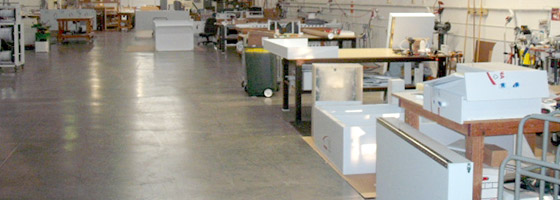Services
Polypropylene, Polyethylene, PVC, CPVC, PVDF, Teflon, Stainless Steel
Polypropylene, Polyethylene, PVC, CPVC, PVDF, Teflon, Stainless Steel
Proplastic Technology is an Industry Leader in the Design and Manufacturing of Custom Plastic Products for CleanRooms, University Labs, and Plating Shops, Wet Process, and numerous other Industries. We produce everything from small parts for other manufacturers, to turnkey plating facilities and University Labs. We produce products to your design or we can help design a product to your specifications. All parts are machined on CNC Routers to ensure accuracy and the best quality products.
Polypropylene (PP), also known as polypropene, is a thermoplastic polymer, made by the chemical industry and used in a wide variety of applications, including packaging, textiles (e.g. ropes, thermal underwear and carpets), stationery, plastic parts and reusable containers of various types, laboratory equipment, loudspeakers, automotive components, and polymer banknotes. An addition polymer made from the monomer propylene, it is rugged and unusually resistant to many chemical solvents, bases and acids.The melting point of polypropylene is very high compared to many other plastics, at 320°F (160°C), which means that it can hold hot fluids with out warping.
The term polyethylene describes a huge family of resins obtained by polymerizing ethylene gas, H2C=CH2, and it is by far the largest volume commercial polymer. This thermoplastic is available in a range of flexibilities and other properties depending on the production process, with high density materials being the most rigid. Polyethylene can be formed by a wide variety of thermoplastic processing methods and is particularly useful where moisture resistance and low cost are required. Low density polyethylene typically has a density value ranging from 0.91 to 0.925 g/cm³, linear low density polyethylene is in the range of 0.918 to 0.94 g/cm³, while high density polyethylene ranges from 0.935 to 0.96 g/cm³ and above.
A polymer made by the catalytic polymerization of vinyl chloride. PVC also includes copolymers that contain at least 50% vinyl chloride. The neat homopolymer is hard, brittle and difficult to process, but it becomes flexible when plasticized. Polyvinyl chloride molding compounds can be extruded, injection molded, compression molded, calendered, and blow molded to form a huge variety of products, either rigid or flexible depending on the amount and type of plasticizers used. There are more compounding recipes for PVC than for any other polymer. Rigid PVC is strong, difficult to burn, has excellent resistance to strong acids and bases, to most other chemicals, and to many organic solvents. Additionally, polyvinyl chloride is one of the least expensive plastics.
CPVC is a thermoplastic produced by chlorination of polyvinyl chloride (PVC) resin. Uses include hot and cold water pipe, and industrial liquid handling. CPVC is a popular engineering material due to its relatively low cost, high glass transition temperature, high heat distortion temperature, chemical inertness, and flame and smoke properties. CPVC is used in a variety of industrial applications where a high functional temperature and resistance to corrosive chemicals are desirable. Besides pipe and fittings, it is used in pumps, valves, strainers, filters, tower packing, and duct, as well as sheet for fabrication into storage tanks, fume scrubbers, large diameter duct, and tank lining. It is also a favored material for hula hoop makers.
PVDF is a specialty plastic material in the fluoropolymer family; it is used generally in applications requiring the highest purity, strength, and resistance to solvents, acids, bases and heat and low smoke generation during a fire event. Compared to other fluoropolymers, it has an easier melt process because of its relatively low melting point of around 177 °C.
In chemistry, polytetrafluoroethylene (PTFE) is a synthetic fluoropolymer of tetrafluoroethylene that finds numerous applications. PTFE is most well known by the DuPont brand name Teflon. PTFE is used as a non-stick coating for pans and other cookware. It is very non-reactive, partly because of the strength of carbon-fluorine bonds, and so it is often used in containers and pipework for reactive and corrosive chemicals. When used as a lubricant, PTFE reduces friction, wear, and energy consumption of machinery.
In metallurgy stainless steel, also known as inox steel or inox from French “inoxydable”, is defined as a steel alloy with a minimum of 10.5 or 11% chromium content by mass. Stainless steel does not stain, corrode, or rust as easily as ordinary steel, but it is not stain-proof. It is also called corrosion-resistant steel or CRES when the alloy type and grade are not detailed, particularly in the aviation industry. There are different grades and surface finishes of stainless steel to suit the environment the alloy must endure. Stainless steel is used where both the properties of steel and resistance to corrosion are required.

Phone: 602-510-2745 | 480-545-8792
Address: 2221 N Nevada St – Chandler, AZ 85225

Phone: 602-510-2745 | 480-545-8792
Address: 2221 N Nevada St – Chandler, AZ 85225
